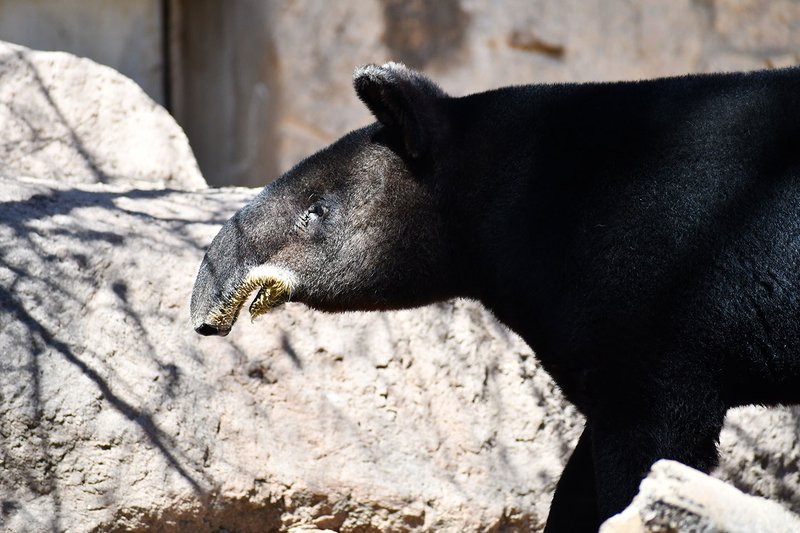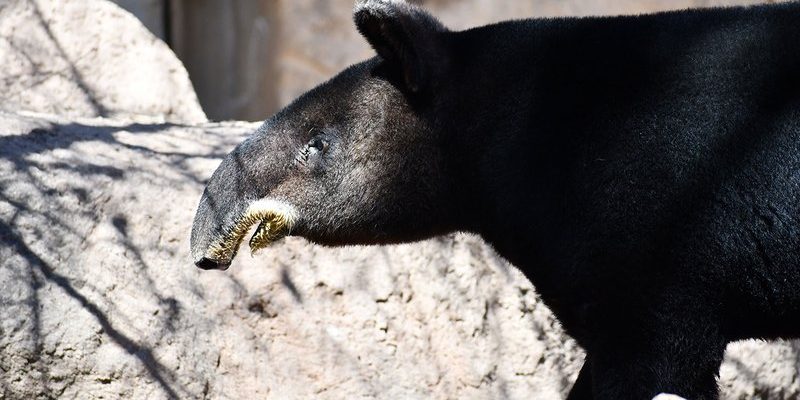
Mountain tapirs are not your everyday wildlife encounter. They roam the high altitudes of Colombia, Ecuador, and northern Peru, often in damp, mossy forest areas. With their dark fur and long, flexible snouts, they’re perfectly adapted to life in these rugged terrains. But before you reach for your camera, it’s important to know how to handle such an encounter wisely, both for your safety and for the tapir’s well-being.
Understanding the Mountain Tapir
Mountain tapirs, or *Tapirus pinchaque*, are the smallest of the tapir family and are often referred to as “the living fossils” because of their ancient lineage. They have a unique, stout body covered in a thick coat of woolly fur that helps them adapt to the cold climates of their mountainous habitats. These creatures are primarily herbivores, munching on leaves, fruits, and grasses.
You might be surprised to learn that mountain tapirs are excellent swimmers. They often seek out water sources to cool down and sometimes even use them to escape predators. Understanding their behavior can help you appreciate them more fully, especially if you stumble upon one during your outdoor adventures.
Recognizing a mountain tapir is the first step in knowing how to act. They stand about 3 feet tall at the shoulder and can reach lengths of nearly 7 feet. If you see one, you’re likely far enough away to observe without alarming it. Remember, these animals are solitary and prefer to keep their distance from humans.
Stay Calm and Observe
The first rule when encountering a mountain tapir is to stay calm. Your heart might race at the sight of such a unique creature, but remember that panicking can lead to unexpected reactions—both from you and the tapir. They’re typically shy and will likely want to avoid you just as much as you want to avoid startling them.
Take a moment to breathe. If you’re with a group, quietly communicate to them to do the same. Oftentimes, a mountain tapir will freeze in place if it senses something unusual. This is a natural instinct to avoid detection. Use the opportunity to observe its behavior. Is it grazing? Looking for water? Watching for predators? These moments can be incredibly rewarding if approached with respect and quietness.
Also, remember to maintain a safe distance. Getting too close can stress the animal, and we don’t want to put it in danger. Use binoculars if you have them, or simply enjoy the sight from afar. Take mental notes (or pictures if you must) but never invade their space.
What NOT to Do
When you encounter a mountain tapir, there are definitely some actions to steer clear of. Here’s a quick list:
- Don’t approach too closely: Getting within arm’s reach can cause stress for the tapir and lead to unpredictable reactions.
- Don’t make loud noises: Yelling or clapping can scare them away or make them feel threatened.
- Don’t feed them: Providing food can disrupt their natural foraging habits and cause harm to their diet.
Here’s the thing: you’re visiting their home, and it’s crucial to respect their space. Tapirs are prey animals and can react defensively if they feel cornered. A frightened tapir might try to escape by running away, which could lead to injury. So, let’s aim for a peaceful interaction!
Creating a Safe Distance
If you find yourself in close proximity to a mountain tapir, it’s a good idea to slowly back away while facing the animal. Backing away lets them know you aren’t a threat. You might be wondering how far is “far enough.” Generally, staying at least 50 to 100 feet away is ideal, depending on the terrain.
It can be helpful to find a natural barrier, like a tree or a rock outcropping, between you and the tapir as you move back. This can give both you and the animal some comfort. Keep your movements slow and deliberate. Rushing could startle them and lead to a flight response.
If you’re hiking with others, keep talking in hushed tones as you retreat. This will not only help keep the atmosphere calm but will also ensure everyone is aware of your shared goal: a safe and respectful viewing experience.
Understanding Their Importance
Mountain tapirs play a crucial role in their ecosystem. As herbivores, they help maintain the vegetation balance by grazing on various plants. By doing so, they support forest health and encourage biodiversity. Understanding the importance of such creatures can deepen your appreciation for the encounter.
Here’s a fun fact: mountain tapirs have a unique digestive system. They can ferment plant material, which helps in nutrient absorption. This means they contribute to soil health through their waste as well. So, when you spot one, you’re looking at a key player in the forest’s ecosystem. Isn’t it fascinating to think of the unseen contributions they make while we hike through their habitat?
Recognizing their role can inspire you to protect the environments they inhabit. It’s a reminder that every creature, no matter how large or small, plays a part in the intricate web of life.
Leave No Trace
Another way to show respect for mountain tapirs is to practice *Leave No Trace* principles while exploring their habitats. This means being mindful about your own impact on the environment. Here are some key rules to follow:
- Stay on marked trails: This minimizes damage to plants and soil.
- Pack out what you pack in: Dispose of trash properly to keep wildlife safe.
- Observe wildlife from a distance: Leave the area as you found it, without disturbing the animals.
By following these guidelines, you not only protect the mountain tapirs but also preserve the beauty of the wilderness for future explorers. Think of it as your way of thanking the forest for the opportunity to witness its wonders.
Gearing Up for Your Adventure
If you’re planning a trip to the mountain tapir’s habitat, being prepared is key. Here’s a short checklist to consider:
- Research the area: Understand where mountain tapirs are commonly seen and the best times to visit.
- Bring binoculars: They allow for a closer look without getting too near.
- Wear appropriate gear: Dress in layers to adapt to changing weather conditions in the mountains.
- Pack snacks and water: Staying hydrated and energized makes for a better experience overall.
Taking a few moments to plan your adventure can make your experience not just enjoyable but memorable. Plus, knowing that you’re respecting the wildlife you encounter will add a deeper layer of fulfillment to your hike.
Encountering a mountain tapir in the wild can be a breathtaking experience, like stumbling upon a living piece of history. Remember, these gentle creatures are vulnerable and deserve our respect. Stay calm, observe from a distance, and always prioritize their well-being over your desire to capture the moment.
By understanding their habitat, importance, and how to interact safely, you can enjoy these encounters while ensuring that mountain tapirs thrive for generations to come. So, next time you lace up your hiking boots, keep these tips in mind and embark on your adventure with both excitement and mindfulness.

